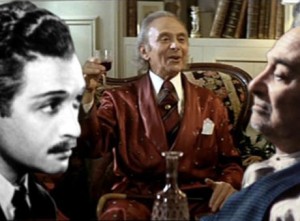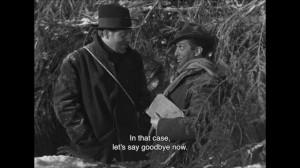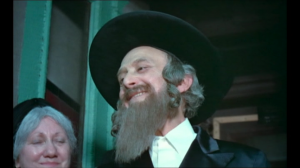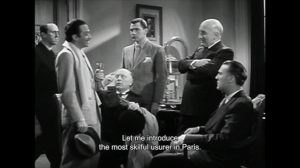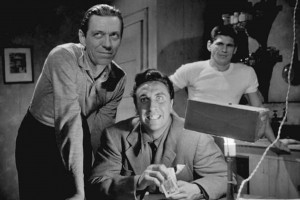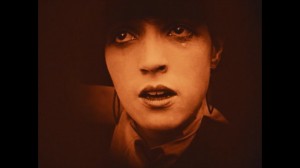Commisssioned by the bilingual, semi-annual Spanish journal Found Footage Magazine for their second issue, published in April 2016.
One good reason for reposting this essay is that Thom Andersen has pointed out a few errors. I’ve added his comments as a postscript. — J.R.
The rapidly and constantly expanding proliferation of films and videos about cinema is altering some of our notions about film history in at least two significant ways. For one thing, now that it has become impossible for any individual to keep abreast of all this work, our methodologies for assessing it as a whole have to be expanded and further developed. And secondly, insofar as one way of defining work in cinematic form and style that is truly groundbreaking is to single out work that defines new areas of content, the search for such work is one of the methodologies that might be most useful. In my case, this is a search that has led to considerations of two recent videos, Mark Rappaport’s 33-minute I, Dalio—or The Rules of the Game (2014) and Thom Andersen’s 108-minute The Thoughts That Once We Had (2015). Both are highly personal works that also define relatively new areas of on-film film analysis, forms of classification that can be described here as indexing (in this case, indexing and commenting on the career of a French character actor, Marcel Dalio) and taxonomy (in this case, illustrating portions of a taxonomy offered by a French writer, Gilles Deleuze, as applied to a partial and idiosyncratic yet fairly comprehensive history of cinema).
For all the differences between Thom Andersen and Mark Rappaport, as essayistic filmmakers working with found footage and as cinephiles, I’d like to start with a few of the things that they have in common. First of all, they’re contemporaries of each other (and of the author of this essay): Andersen was born in 1943 (as was I), Rappaport in 1942. (In the interests of full disclosure, I should add that both of them have been personal friends for several decades.) Both started out as independent filmmakers whose early works, to the best of my knowledge, are not especially dependent on found footage (with the partial and notable exception of Andersen’s 1974 masters thesis at UCLA, Eadweard Muybridge, Zoopraxographer). Both are accomplished and distinctive writers and critics as well as filmmakers whose published essays (and, in Rappaport’s case, stories) are compatible and complementary with their work as filmmakers, which in recent years has gravitated towards extensive, often idiosyncratic, and highly personal uses of found footage. And both of the 2015 films of theirs that I propose to examine here allude directly to other films in their very titles: Andersen’s title comes from a poem by Christina Rossetti that is quoted in Robert Aldrich’s 1955 Kiss Me Deadly (in a clip included at the end of Andersen’s film), whereas Jean Renoir’s 1939 La règle du jeu is more implicitly referenced in Rappaports’ title.
The most distinctive differences between these films can be traced in part to the respective careers of their makers. Andersen, who has lived in Los Angeles for most of his life, has been teaching filmmaking at the California Institute of the Arts since 1987, and The Thoughts That Once We Had grew directly out of his course lectures in which he applied the taxonomies found in two complementary books by Gilles Deleuze, Cinéma 1: L’Image-Mouvement, translated in English by Hugh Tomlinson and Barbara Habberjam as Cinema 1: The Movement-Image and and Cinéma 2: L’Image-Temps, translated in English by Hugh Tomlinson and Robert Galeta as Cinema 2: The Time-Image. These two volumes are essentially philosophical works in which Deleuze’s formulated categories are cinematic modes of thought, and Andersen’s illustrations of these categories are both interpretive and personal, based on his own cinephilia and on his own political concerns (the latter of which are foregrounded, to a much greater degree than Deleuze’s are).[i] As Andersen describes his own film in an early intertitle, it is “A personal history of cinema, partially inspired by Gilles Deleuze, The Movement-Image and The Time-Image”.
Andersen’s best known previous film using found footage, the 169-minute Los Angeles Plays Itself (2003), similarly grew out of a course lecture at Cal Arts critiquing Curtis Hanson’s 1997 L.A. Confidential, which led to other taxonomies regarding depictions of Los Angeles in films, and his special interest in architecture, which informs much of Los Angeles Plays Itself, led to his commissioned 2012 documentary about the work of Eduardo Souto Moura, Reconversion, made in Portugal. Other interests—experimental filmmaking, blacklisted Hollywood filmmakers, racial and ethnic minorities, and popular culture (in particular, American car culture)—have informed both Los Angeles Plays Itself and some of his other films, ranging from his early structural film Melting (1965) to his 1996 Red Hollywood (made jointly with Noël Burch, and employing many film clips) to his 2010 Get Out of the Car to his more recent found-footage shorts, The Tony Longo Trilogy (2014) and Juke – Passages From the Films of Spencer Williams (2015).
Rappaport was born in New York and he lived and (mostly) worked there until he moved to Paris in 2003, although his work with found footage started over a decade earlier with Rock Hudson’s Home Movies (1992), followed by Exterior Night (made in Germany for German television in 1993), From the Journals of Jean Seberg (1995), The Silver Screen: Color Me Lavender (1997), and his 2002 short John Garfield. Since his move to Paris, he has published a collection of his (fictional and non-fictional) essays in French (Le Spectateur qui en savait trop, translated by Jean-Luc Mengus, Paris: P.O.L, 2008) and three online collections in English available in Kindle editions on Amazon: The Moviegoer Who Knew Too Much (2013), (F)au(x)tobiographies (2013), and The Secret Life of Moving Shadows (available in two parts, 2014). He has also exhibited photomontages in New York, Paris, and elsewhere over the past several years — and it should be added that his interests in the Victorian novel (which he studied at Brooklyn College), melodrama, and art history have informed much of his work, from his nine features made in New York to his more recent short videos (Becoming Anita Ekberg, 2014, The Vanity Tables of Douglas Sirk, 2015, Our Stars, 2015, The Circle Closes, 2015, and the aforementioned I, Dalio, and Debra Paget, For Example, 2015, all made over the past three years).
Some of these videos, including I, Dalio, adopt the form of fictional autobiography that Rappaport used in Rock Hudson’s Home Movies and From the Journals of Jean Seberg — employing actors who play the eponymous subjects recounting their careers (exclusively offscreen, by Tito de Pinho, in I, Dalio, speaking in English with a French accent) and commenting on clips from their films. The comments, all written by Rappaport, allow the actor’s stand-in to serve as a kibbitzer (a Yiddish term for a commentator whose remarks are most often uninvited and irreverent) on the clips while pretending to be Hudson, Seberg, Ekberg, Dalio, or Paget, and they frequently match the novelistic methodologies of his fictional essays by using fiction to broaden as well as dramatize Rappaport’s analysis, sometimes creating in effect conversations between Rappaport and the films he discusses. And indexing certain roles and performances by these actors to make certain points is the most common procedure. Thus Hudson’s closeted homosexuality and Seberg’s ambiguous “blank” expressions, seen cumulatively over several roles and films, become the basis for social critiques and, in the case of Seberg, a certain amount of film theory tied to the famous “Kuleshov experiment”. In the case of Marcel Dalio — born with the name Israel Moshe Blauschild in Paris’s main Jewish neighborhood in 1900 — this becomes the basis of indexing Dalio’s mainly unsympathetic roles in prewar French cinema, which are plausibly shown to be cumulatively and implicitly (if not always individually) anti-Semitic: “In the French films of the 30s, I play every kind of scoundrel, and I’m called every name imaginable — except one.” Significantly, the two exceptions discussed are Jean Renoir’s La Grande Illusion (1937) and La règle du jeu (1939), where he plays sympathetic aristocratic Jews, explicitly identified as Jewish. But then, after the Nazi occupation of France forces Dalio to emigrate to the U.S., we discover that his Hollywood roles are subject to a different kind of typecasting in which his Judaism becomes both irrelevant and ignored and he becomes stereotyped simply as “French,” most often in comic and whimsical parts.
After we see Dalio playing a hotelier named Frenchy in To Have and Have Not (Howard Hawks, 1944), we hear his stand-in say, “I was no longer the ‘Jew’ with quotes around it. No one cared about that anymore. Now I was simply The Frenchman. The rules of the game suddenly changed. It was that easy. It just depended on where you were and who was defining you.” But this provocative conclusion is by no means all of I, Dalio; Rappaport also traces briefly the screen careers of Dalio’s three wives (two in France, one in the U.S.) and his returns to Europe after the war (occasioning some reversions to being cast as more unsavory types), the less apparent Jewish identities of some of French colleagues and costars (such as Jean-Pierre Aumont and Simone Signoret, who didn’t, like him, wind up on Nazi posters representing “typical” Jews — although Rappaport gets to imagine what such posters would have looked like), and other diverse tangents and asides that emerge from rummaging through Dalio’s filmography. Yet the unifying thread is Dalio’s separate personas in French cinema and Hollywood, and many mitigating factors are brought into the discussion. “Paradoxically, the French respected me more, and I almost always got a full film credit (illustrated by several clips,) even for a small role,” while a scene in the 1960 Hollywood musical Can-Can (Walter Lang) shows Dalio, “a Jew who fled Hitler,” with two other stereotypical French actors, Louis Jourdan, “[who] fought in the Resistance,” and Maurice Chevalier, “who did not resist very strenuously”. The fictional Dalio then remarks, “You might well wonder what we talked about between takes,” and the real Dalio (still in Can-Can) replies, “I’m not allowed to tell, sir.”
This is shortly followed by the observation, amply illustrated, that “A Frenchman in America can play a priest, a Jew in France cannot.” And finally, with the onset of old age, “I was no longer a type. I was neither Frenchy nor a devious Jew. I was just an old man.” And then back in France, in 1973, ten years before his death, he plays Rabbi Jacob in a hit comedy.
This, in short, outlines the new areas of “content” created as well as discovered by Rappaport while indexing the found footage of Dalio’s filmography, which also includes the effacement of his name from the credits and/or the effacement of his actual presence (as a Jew) in two 1938 French features when these were rereleased in Nazi-occupied France. And the obvious virtue of using film rather than prose to handle this material is that it proves Rappaport’s points through concrete demonstration. (For the same reason, Rappaport fictional and non-fictional essays often make integral uses of illustrations.) As Godard once said to Pauline Kael in a public discussion,
(…) the image is like evidence in a courtroom. For me, making a movie is like bringing in evidence… That’s why I’m not working in criticism anymore these days — practically — because there words always come first… To me, a good review, good criticism (whether it is in Cahiers du Cinéma or Film Comment) would be trying not to say ‘I don’t feel’ ‘I don’t see it the way you saw it,’ but, rather, ‘Let’s see it, let’s bring in the evidence’ (Godard & Kael, 1982:175-176).
Rappaport’s own biography makes him ideally suited to index Dalio’s work in this manner — not only because his own move from the U.S. to France predisposes him to observe differences in their two mainstream cinemas, but also because living in Paris clearly gave him access to a good many European films that wouldn’t have had otherwise. By the same token, Andersen’s approaches to his own subject — and, indeed, his subject itself — are inextricably tied to his career as an academic. I should add that even though I possess copies of both Deleuze volumes in both their French and American editions, I haven’t read either of them in their entirety, although I have often dipped into their pages for their insights into particular films and filmmakers, and a quarter of a century ago I had occasion to ridicule the practice of the English translators in translating many of the French film titles literally, without recourse to their Anglo-American equivalents, yielding such imaginary film objects as Joseph L. Mankiewicz’s The Bloodhound (Sleuth,1972), Vincente Minnelli’s The Perfect Wife (Designing Woman, 1957), and Max Ophüls’ House of Pleasure (Le Plaisir, 1952), among many others, including “even a Marguerite Duras Western (Destry She Said, Détruire dit-elle, 1969),”[ii] as well as various other errors and confusions. Not being a professional academic myself (apart from a few freelance positions) and working for most of my career as a journalist, I am more prone to plunder academic texts for insights than to teach them in courses, which places me closer to Rappaport’s methodologies than to those of Andersen.
I should stress, however, that Andersen’s employments of Deleuze are as personal as the subjective plundering practices of Rappaport and myself. And his procedures are much harder to outline because they veer between being systematic and unsystematic: an early intertitle assures us, “All quotations are from Deleuze, unless otherwise attributed,” yet when the phrase “…motherless Brooklyn…” appears between clips from Jem Cohen’s 2008 Evening’s Civil Twilight in Empires of Tin, the phrase clearly can’t be attributed to Deleuze, although we’re provided with no other source. Moreover, the extremely broad and eclectic assortment of films chosen — fiction films as well as documentaries; commercial genre movies as well as art films; films from North America, Europe, and Asia (but none from South America or the Middle East); a surveillance video (of a Patty Hearst bank robbery); a soft-core porn feature; and even an indexing of one particular Hollywood character actor (Timothy Carey) — often fulfill categories that are quite independent of Deleuze’s, e.g., “Wittgenstein’s favorite movie star” (Carmen Miranda in Nancy Goes to Rio [Robert Z. Leonard, 1950]), “Jack Smith’s favorite movie star” (Maria Montez in Cobra Woman [Robert Siodmak, 1944]), and “My favorite movie star” (Debra Paget in The Tiger of Eschnapur (Der Tiger von Eschnapur, Fritz Lang, 1959), dancing with an obscenely erect cobra). Even more personally, near the end of Andersen’s feature, we hear the strains of “Am I Blue?” in To Have and Have Not over black leader and then the printed declaration, “Long before there was VHS and Betamax, I recorded the soundtrack of To Have and Have Not on a reel-to-reel tape recorder and listened to it over and over. This discovery of the soundtrack inspired me to become a filmmaker.”
This doesn’t mean that Andersen is either formless or random in his choices — these are often exhilarating and unexpectedly apt — only that, in certain respects, he is interested in subverting and/or expanding Deleuze’s taxonomies. He begins fairly conventionally with ”the affection-image”, Deleuze’s term for the close-up, which he illustrates with clips from seven Griffith films and three Stroheim films. (Later on, he is similarly precise in illustrating some of Deleuze’s comedy classifications via Langdon, Laurel and Hardy, and the Marx Brothers.) But then he suddenly shifts to a violent labor struggle seen in long shot in Griffith’s Intolerance (1916) and work on a dam in Dziga Vertov and Elizaveta Svilova’s The Eleventh Year (Odinnadtsatyy, 1928), the latter buttressed by quotes from Deleuze about Soviet dialectical montage and Vertov. From there he moves respectively to “managers” (Pudovkin’s The End of St. Petersburg (Konets Sankt-Peterburga, 1927)), “capitalists” (L’Herbier’s L’Argent (1928)), “Communists” (Vertov’s Enthusiasm (Entuziazm (Simfoniya Donbassa), 1931), and then “spies” (Marlene Dietrich in Sternberg’s Dishonored [1931]). The latter yields two more quotes from Deleuze about “lyrical abstraction” that is “defined by the relationship of light with white”, and we move from there to Sternberg’s Shanghai Express (1932) and The Scarlet Empress (1934). Then another Deleuze quote (“A new wave for the affection-image?”) ushers in close-ups from Godard’s Breathless (À bout de souffle, 1960), Vivre sa Vie: Film en douze tableaux (1962), Two or Three Things I Know About Her (2 ou 3 choses que je sais d’elle, 1967), Made in U.S.A. (1966) (in this case, of a bloody skeleton), and King Lear (1987) (four separate close-ups, combined first with theme music from Breathless and then with sound effects from Notre Musique [2004]), then from Cassavetes’ Love Streams (1984) and Costa’s In Vanda’s Room (No Quarto da Vanda, 2000).
Even more unorthodox is Andersen’s periodic use of place names and dates, which have shifting meanings and functions: “St. Petersburg 1914”, used in relation to the Pudovkin clip, references a historical event being re-enacted; in a string of massive man-made atrocities which have no counterpart in Deleuze — “LENINGRAD/ JANUARY 1942”, “NORTH KOREA/1950-1953”, ‘HIROSHIMA/1958”, “VINH LINH/ VIETNAM/1967” — the first two and the fourth are illustrated by clips from documentaries made respectively in 2006, 1988, and 1967, whereas the third assigns the date to the clip itself (from Resnais’ Hiroshima Mon Amour (1959), which mixes documentary with pseudodocumentary footage),[iii] rather than to the events that it depicts, some of which occurred in 1945. And to confound matters further, the aforementioned Debra Paget clip is labeled “ESCHNAPUR/RAJASTHAN/ INDIA/1958,” but in keeping with the intertitle about the soundtrack of To Have and Have Not, two subsequent clips from films that show characters listening to blues records (Aki Kaurismaki’s Le Havre [2011] and Zwigoff’s Ghost World [2001]) are dated according to when these records were made, not when these films were released.
I’ve only sketched in a few of the ways that Andersen has implicitly fashioned an indirect critical commentary on Deleuze in the process of illustrating and expanding his concepts, in contrast to Rappaport’s more streamlined and systematic critique of typecasting in French and Hollywood features. My major point, in any case, is to suggest two broad approaches towards film criticism using found footage that create many fruitful possibilities.
NOTES
[i] Almost all of the quotations used come from Deleuze’s first volume, The Movement-Image, and the only one I’ve spotted from The Time-Image is retranslated, even though the grammatical error in the English original is retained: “The cinematographic act consists in [sic] this: that the dancer himself begins dancing, as one starts to dream” becomes “The cinematic act consists in [sic] this: that the dancer…begins dancing, as one begins to dream” (The Time-Image, op. cit., 61).
[ii] Jonathan Rosenbaum, ‘Orson Welles’s Essay Films and Documentary Fictions: A Two-Part Speculation,’ reprinted in both Placing Movies: The Practice of Film Criticism (Rosenbaum, 1995:171-183) and Discovering Orson Welles (Rosenbaum, 2007:129-145).
[iii] In the same clip, Andersen replaces the fictional male narrator’s offscreen dialogue with intertitles while retaining the fictional female narrator’s dialogue in its original form.
BIBLIOGRAPHY
Deleuze, Gilles (1983). Cinéma 1: L’Image-Mouvement. Paris: Les Éditions de Minuit.
Deleuze, Gilles (1983). Cinéma 2: L’Image-Temps. Paris: Les Éditions de Minuit.
Deleuze, Gilles (1986). Cinema 1: The Movement-Image. Translated by Hugh Tomlinson and Barbara Habberjam. Minneapolis: University of Minnesota Press.
Deleuze, Gilles (1989). Cinema 2: The Time-Image. Translated by Hugh Tomlinson and Robert Galeta. Minneapolis: University of Minnesota Press.
Godard, Jean-Luc & Kael, Pauline (1982). ‘The Economics of Film Criticism: A Debate,’ Camera Obscura, no. 8-9-10, Fall 1982, pp. 162-185.
Rosenbaum, Jonathan (1995). Placing Movies: The Practice of Film Criticism. Berkeley/Los Angeles/London: University of California Press.
Rosenbaum, Jonathan (2007). Discovering Orson Welles. Berkeley/Los Angeles/London: University of California Press.
***
Postscript: Thom Andersen sent me the following email on July 26, 2017:
Dear Jonathan,
Thanks for the link. The publishers didn’t send me a copy.
For me it is an honor to be considered in relation to the great Mark Rappaport, who was my primary inspiration for Red Hollywood and the “found footage” films that followed. He showed me that a movie about other movies didn’t have to be pious.
I’m glad you wrote about I, Dalio; I was very moved by it, and I regard it as one of Mark’s best.
And thank you for your close attention to my text. I was somewhat awed by your erudition.
Allow me to mention a few mistakes, however. You are right that most of the Deleuze quotes come from The Movement-Image, but there are actually seventeen quotations from The Time-Image; in the last half-hour, almost all of the Deleuze quotes come from The Time-Image. I think you didn’t appreciate that there are so many quotes from the second book because there are no references to the time-image itself. That may be the subject of a sequel.
In fact, all of the quotations that are not otherwise attributed do come from Deleuze.
There are no quotation marks around “… motherless Brooklyn…”; it is, of course, the title of a Jonathan Lethem book. I checked because I thought you had pointed out a mistake.
The soft-core porn movie is actually hard-core although there is no way of knowing that unless you recognize the film.
All of the scenes have some relation to Deleuze’s ideas, but again there is no way of knowing that unless you are very familiar with his cinema books.
You should also be aware that “A new wave for the affection-image?” is not a Deleuze quotation. It is not in quotation marks.
It’s frustrating that the spellcheck program on my email automatically changes “Deleuze” to “Delouse”and “Deleuze’s” to “Deluge’s.”
Yours,
Thom

